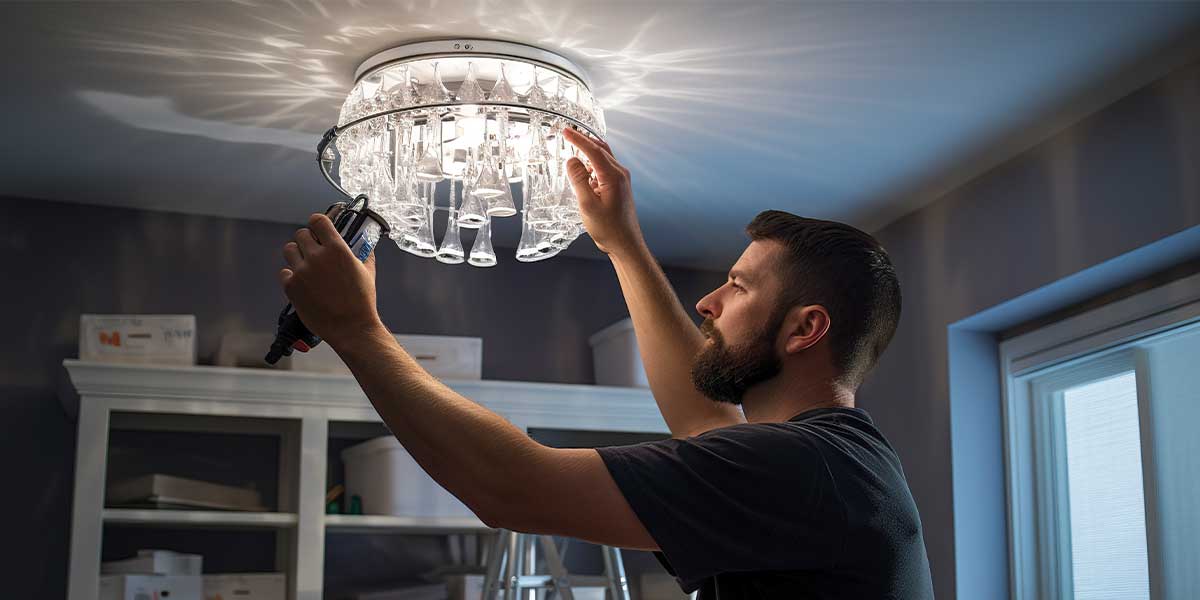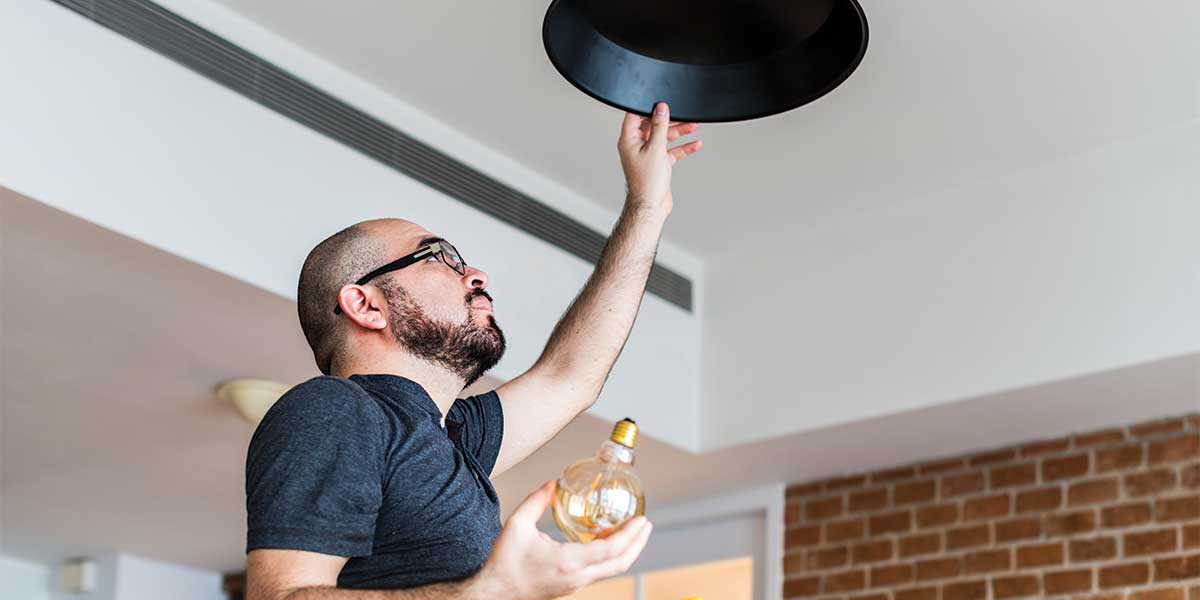Lighting is more than just functional, it’s transformative. At Expert Electric, we know that replacing or maintaining your light fixtures is one of the easiest and most affordable ways to improve both the safety and style of your home. Whether your light fixtures are outdated, malfunctioning, or simply dusty and dim, our light fixture replacement and maintenance tips will help you brighten your space with confidence and ease.
Let’s walk through how you can safely replace a fixture, keep your lighting clean and efficient, and know when to call in the pros.
Why Light Fixture Replacement and Maintenance Matters
- Old or neglected light fixtures can lead to:
- Reduced energy efficiency
- Poor lighting quality
- Potential electrical hazards
- Increased utility bills
- Decreased property value
Maintaining and updating your light fixtures not only keeps your home looking fresh but also ensures your electrical system remains safe and efficient.
How to Replace a Light Fixture: Step-by-Step Instructions
Replacing a light fixture doesn’t have to be intimidating. If you’re a confident DIYer and understand electrical safety, you can tackle this task on your own. However, if you’re ever unsure, always call a licensed electrician.
Need a visual guide? Check out this helpful resource on how to replace a light fixture from Family Handyman.
Here are the proper steps to follow for a safe and smooth light fixture replacement:
1. Turn Off Power at the Electrical Panel
Before touching anything, locate the appropriate circuit breaker and turn off the power to the room where you’re working. Use a non-contact voltage tester to confirm no electricity is flowing.
2. Remove the Old Fixture
- Carefully remove any glass covers or light bulbs.
- Unscrew the base or mounting hardware to detach the fixture.
- Disconnect the wires by unscrewing the wire nuts and separating the fixture wires from the house wiring.
3. Inspect and Tighten the Electrical Box
Ensure the ceiling electrical box is properly secured. If it’s loose or damaged, do not install the new fixture until it’s replaced or reinforced.
Tip: If the existing box isn’t rated to support the weight of your new fixture (especially chandeliers or ceiling fans), call a professional.
4. Connect the New Fixture
Follow the manufacturer’s instructions carefully. Generally, you’ll:
- Strip ½ inch of insulation from the wires.
- Connect black to black (hot), white to white (neutral), and green or bare copper to ground.
- Use wire nuts and wrap connections with electrical tape for extra security.
5. Mount the Fixture
Secure the fixture to the electrical box using the supplied screws. Double-check that everything is aligned and tight.
6. Add Light Bulbs and Restore Power
Install bulbs of the correct wattage rating as indicated on the fixture. Turn the power back on at the breaker and test your new lighting!
Light Fixture Maintenance Tips to Keep Things Bright
Replacing your fixtures is only part of the story. Regular maintenance helps extend their lifespan, reduce fire risk, and keep your home looking spotless.
Clean Your Fixtures Regularly
Dust and grime can reduce light output and affect performance. Here’s how to tackle different types of fixtures:
Chandeliers
- Turn off the power and remove bulbs.
- Drape a towel over a table and carefully lay the chandelier down.
- Mix a cleaning solution: 1 oz of mild dish soap, ¼ cup white vinegar, 3 cups warm water.
- Spray and wipe each crystal piece using a microfiber cloth.
Ceiling Fixtures
- Detach the cover and clean it in warm, soapy water.
- Rinse and polish with a dry microfiber cloth.
- Wipe bulb bases and sockets gently with a dry cloth.
Pendant Lights
- Turn off power and allow bulbs to cool.
- Spray the outside of the shade with cleaner and wipe with a microfiber cloth.
- Wipe extension rods and cords with a dry cloth.
Recessed Lights
- Use a slightly damp cloth to clean the inside of the can and the bulb.
- Avoid moisture around the trim or socket.
Pro Tip: Replace any burnt-out bulbs immediately to prevent uneven wear on multi-bulb fixtures.

Energy-Efficient Lighting: Upgrade Your Bulbs Too
While updating your fixtures, consider switching to LED bulbs. They:
- Last 25x longer than incandescent bulbs
- Use up to 80% less energy
- Come in a variety of colour temperatures
- Produce less heat, which is safer and better for enclosed fixtures
Common Light Fixture Issues and Troubleshooting Tips
Flickering Lights?
- Could be caused by a loose bulb or wire connection.
- Check if your dimmer switch is compatible with LED bulbs.
Buzzing Sound?
- May be caused by incompatible bulbs or faulty ballast.
- Replace the bulb or consult an electrician if the sound persists.
Bulbs Burning Out Too Fast?
- Check for incorrect wattage or poor air circulation in the fixture.
- If the socket shows signs of scorching or warping, it needs replacement.
When to Call a Professional Electrician
Even if you’re handy, not all light fixture jobs are DIY-friendly. Call Expert Electric if:
- Your wiring is old or brittle (especially knob-and-tube or aluminum)
- You’re installing a heavy fixture like a chandelier or ceiling fan
- You’re upgrading to smart lighting or dimmer switches
- You need help locating the correct circuit or diagnosing a fixture that still won’t work
Don’t risk electrical fires or injury, let the pros handle it safely and efficiently.
FAQs About Light Fixture Replacement and Maintenance
How often should I clean my light fixtures?
Ideally, clean them every 3–6 months, especially in kitchens or bathrooms where grease or humidity builds up.
Can I replace a light fixture myself?
Yes, if you understand basic wiring and follow safety guidelines. However, for complicated fixtures, outdated wiring, or ceiling fans, it’s best to call a licensed electrician.
How do I know if a light fixture is too old?
If it flickers, buzzes, overheats, or has signs of corrosion or frayed wires, it’s likely time for a replacement.
Do I need a permit to change a light fixture in BC?
For simple replacements, no permit is required. But if you’re adding new wiring or changing circuit loads, you’ll need to check with your local authorities or consult Expert Electric.
Are LED bulbs better for my light fixtures?
Absolutely. LEDs are more energy-efficient, safer, and come in a variety of designs that suit nearly any fixture style.
Final Thought: Let There Be Light, Safely and Beautifully
Replacing and maintaining your light fixtures may seem like a small task, but it can have a big impact on your home’s comfort, safety, and energy efficiency. Whether you’re swapping outdated fixtures or simply polishing up what you already have, these light fixture replacement and maintenance tips will help your home sparkle.
But don’t go it alone. Expert Electric is here to illuminate your home with expertise and care. Our licensed electricians serve homeowners and businesses across BC with prompt, professional service and friendly advice. We’re passionate about keeping your space safe, functional, and beautifully lit.
Contact Expert Electric
Ready to upgrade your lighting or need help with an electrical issue?
Call us today at 604-681-8338
Email: info@expertelectric.ca
Let’s make your home shine safely, beautifully, and efficiently.


